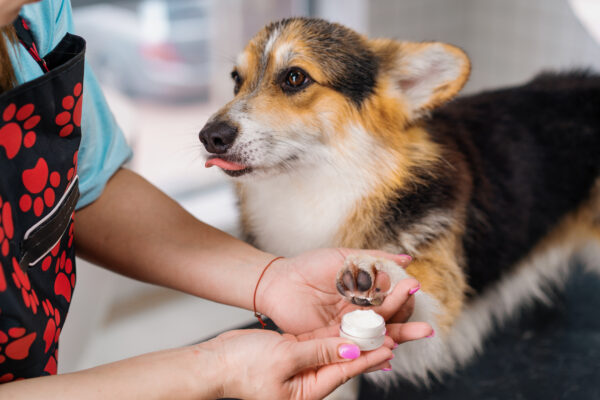p { font-size: 18px; line-height: 1.6; } table { width: 100%; border-collapse: collapse; } table, th, td { border: 1px solid black; } caption { font-weight: bold; margin-bottom: 10px; } th, td { padding: 10px; text-align: left; } h2, h3 { color: #2E8B57; } ul { margin-left: 20px; }
Itching, or pruritus, is a common and often frustrating problem for dog owners and veterinarians alike. While antihistamines are a go-to remedy for allergic reactions in humans, their effectiveness in controlling itch in dogs is frequently questioned. In this comprehensive guide, we’ll explore the reasons behind the limited success of antihistamines in treating canine itch, delve into alternative treatment options, and provide insights to help your furry friend find relief. Whether you’re a pet owner seeking answers or a veterinary enthusiast, this article offers valuable information to enhance your understanding of this complex issue.
Table of Contents
- 1. Understanding Itch in Dogs
- 2. The Role of Antihistamines
- 3. Why Antihistamines Often Fail in Dogs
- 4. Alternative Treatments for Canine Itch
- 5. Managing Allergies Holistically
- 6. When to Consult a Veterinarian
- 7. Case Studies and Research Findings
- 8. Frequently Asked Questions
- 9. Conclusion
1. Understanding Itch in Dogs
1.1 What Causes Itching in Dogs?
Itching in dogs can be caused by a variety of factors, including:
- Allergies: Environmental allergens (pollens, molds, dust mites), food allergies, and flea allergies are common culprits.
- Parasites: Fleas, ticks, and mites can cause intense itching and discomfort.
- Infections: Bacterial and fungal infections of the skin can lead to itching.
- Dry Skin: Low humidity and poor diet can contribute to dry, itchy skin.
- Underlying Diseases: Conditions like hypothyroidism or autoimmune diseases may manifest as skin problems.
1.2 The Impact of Chronic Itching
Chronic itching not only affects a dog’s comfort but can lead to secondary skin infections, hair loss, and behavioral changes due to constant discomfort. Addressing the root cause is essential for effective treatment and improving the dog’s quality of life.
2. The Role of Antihistamines

2.1 How Antihistamines Work
Antihistamines are medications that block histamine receptors in the body. Histamine is a chemical released during allergic reactions, leading to symptoms like itching, swelling, and redness. By blocking histamine, antihistamines aim to reduce these symptoms.
2.2 Common Antihistamines Used in Dogs
Some antihistamines prescribed for dogs include:
- Diphenhydramine (Benadryl): Often used for mild allergic reactions.
- Chlorpheniramine: May be recommended for atopic dermatitis.
- Hydroxyzine: Sometimes used for more severe allergies.
- Loratadine (Claritin): Occasionally prescribed, but efficacy varies.
It’s important to note that dosages for dogs differ from humans, and veterinary guidance is essential.
3. Why Antihistamines Often Fail in Dogs
3.1 Differences in Histamine Receptors
One primary reason antihistamines are less effective in dogs is due to differences in histamine receptor distribution and function between species. Dogs have fewer histamine (H1) receptors in their skin compared to humans (Marsella & Olivry, 2010). This means that histamine plays a smaller role in canine itching.
3.2 Multiple Mediators of Itch
In dogs, itch is mediated by a complex interplay of chemicals beyond histamine, such as cytokines, proteases, and neuropeptides. Antihistamines target only histamine, leaving other itch-causing mediators unaddressed.
3.3 Timing of Administration
Antihistamines are more effective when used preventatively rather than as a treatment for existing itch. If administered after itch symptoms have started, their efficacy decreases significantly.
3.4 Variable Absorption and Metabolism
Individual variations in how dogs absorb and metabolize antihistamines can affect their effectiveness. Some dogs may respond better than others, but overall, the response rate is low (Scott et al., 2004).
3.5 Underlying Conditions
Antihistamines may fail because they do not address the root cause of the itch, such as parasites, infections, or hormonal imbalances. Treating the underlying condition is crucial for effective relief.
4. Alternative Treatments for Canine Itch

4.1 Corticosteroids
Corticosteroids like prednisone are potent anti-inflammatory agents that can provide rapid itch relief. However, they come with potential side effects, especially with long-term use, such as increased thirst, hunger, and risk of infection.
4.2 Apoquel (Oclacitinib)
Apoquel is a newer medication that inhibits Janus kinase (JAK) enzymes, interrupting the itch and inflammation pathway. It offers quick relief and is generally well-tolerated (Cosgrove et al., 2014).
4.3 Cytopoint (Lokivetmab)
Cytopoint is a monoclonal antibody injection that targets and neutralizes interleukin-31 (IL-31), a key itch mediator in dogs. It provides relief for 4–8 weeks per injection with minimal side effects.
4.4 Fatty Acid Supplements
Omega-3 and omega-6 fatty acids support skin health and can reduce inflammation. Supplements or diets rich in these fatty acids may alleviate mild itching.
4.5 Topical Therapies
Medicated shampoos, sprays, and ointments containing ingredients like oatmeal, aloe vera, or hydrocortisone can provide localized relief.
4.6 Allergen-Specific Immunotherapy
For dogs with atopic dermatitis, allergy testing followed by immunotherapy (allergy shots or drops) can reduce sensitivity to specific allergens over time.
5. Managing Allergies Holistically
5.1 Identifying Allergens
Work with your veterinarian to identify potential allergens through testing or elimination diets. Common allergens include certain proteins, grains, or environmental factors like pollen and dust.
5.2 Environmental Control
Minimize exposure to known allergens:
- Regularly clean bedding and living areas.
- Use air purifiers to reduce airborne allergens.
- Bathe your dog with hypoallergenic shampoos to remove allergens from the coat.
- Control fleas and other parasites diligently.
5.3 Dietary Management
A balanced diet with high-quality ingredients supports overall health and skin integrity. For food allergies, a veterinary-prescribed elimination diet may be necessary to identify and remove offending ingredients.
5.4 Supplementation
Consider supplements that promote skin health:
- Probiotics: Support gut health and immune function.
- Antioxidants: Reduce oxidative stress and inflammation.
- Herbal Remedies: Ingredients like quercetin or licorice root may have anti-inflammatory properties (consult your veterinarian first).
6. When to Consult a Veterinarian
6.1 Signs That Warrant Immediate Attention
If your dog exhibits any of the following, seek veterinary care promptly:
- Severe or persistent itching.
- Open sores, scabs, or signs of infection.
- Hair loss or bald patches.
- Lethargy or changes in behavior.
- Adverse reactions to medications.
6.2 Diagnostic Procedures
Your veterinarian may perform:
- Skin scrapings or cytology to check for parasites or infections.
- Allergy testing (intradermal or serum tests).
- Blood tests to assess overall health.
- Elimination diets for suspected food allergies.
6.3 Developing a Treatment Plan
A tailored treatment plan may include a combination of medications, dietary changes, and environmental modifications. Regular follow-ups are essential to monitor progress and adjust the plan as needed.
7. Case Studies and Research Findings
7.1 Clinical Studies on Antihistamine Efficacy
A study published in the Veterinary Dermatology journal evaluated the effectiveness of antihistamines in dogs with atopic dermatitis. The findings indicated that less than 20% of dogs showed significant improvement (Miller et al., 2001).
7.2 Comparative Studies with New Therapies
Research comparing Apoquel and Cytopoint demonstrated higher efficacy and faster relief compared to antihistamines and even corticosteroids, with fewer side effects (Michels et al., 2016).
7.3 Owner Experiences
Many pet owners report frustration with antihistamines, noting minimal improvement in their dogs’ itching. In contrast, alternative treatments like Apoquel or immunotherapy have provided substantial relief for their pets.
8. Frequently Asked Questions
Q1: Can I give my dog over-the-counter antihistamines meant for humans?
A: Some human antihistamines can be used in dogs, but dosages differ, and not all are safe. Always consult your veterinarian before administering any medication.
Q2: Are there any risks associated with antihistamines in dogs?
A: Side effects may include drowsiness, dry mouth, or urinary retention. Antihistamines may also interact with other medications.
Q3: Why do antihistamines work for some dogs but not others?
A: Individual variations in histamine receptor sensitivity and metabolism can influence effectiveness. Additionally, if histamine is not the primary mediator of itch, antihistamines will be less effective.
Q4: Can I use natural remedies to help my dog’s itching?
A: Some natural remedies like oatmeal baths or aloe vera may provide temporary relief. However, it’s important to address the underlying cause, and natural remedies should complement, not replace, veterinary care.
Q5: Is long-term use of corticosteroids safe for my dog?
A: Long-term steroid use can lead to significant side effects, including immune suppression, weight gain, and hormonal imbalances. Alternative treatments are often preferred for chronic conditions.
9. Conclusion
While antihistamines are a staple in human allergy management, their limited efficacy in controlling itch in dogs stems from physiological differences and the complex nature of canine itching. Understanding the reasons behind this can guide pet owners toward more effective treatments. Collaborating with your veterinarian to identify the underlying cause and develop a comprehensive treatment plan is essential. By exploring alternative therapies and adopting a holistic approach to allergy management, you can help your canine companion find much-needed relief and improve their quality of life.
For all your pet care needs, including specialized skin care products, supplements, and accessories to support your dog’s health, visit Flawless Cuties, your trusted partner in pet wellness.
Can I Pet That Dog? A Comprehensive Guide to Safe and Enjoyable InteractionsObedience Puppy Training: A Step-by-Step GuideTop 10 Best Dog Breeds for Apartments: A Comprehensive GuideThe Best Homemade Dog Food Recipes: A Comprehensive GuideI Don’t Want to Hit My Dog, But I Want Them to Obey – What Should I Do? Here’s How to Train Your Dog Positively
Travel Essentials for Pets
Managing your dog’s allergies and skin conditions while traveling can be challenging. Equip yourself with the right travel essentials to ensure your pet remains comfortable on the go.
References
- Cosgrove, S. B., et al. (2014). Evaluation of the efficacy and safety of oclacitinib in the control of pruritus associated with allergic dermatitis in dogs. Journal of the American Veterinary Medical Association, 244(5), 509-514. doi:10.2460/javma.244.5.509
- Marsella, R., & Olivry, T. (2010). Animal models of atopic dermatitis. Clinical Dermatology, 28(1), 18-24. doi:10.1016/j.clindermatol.2009.03.003
- Michels, G. M., Ramsey, D. S., & Walsh, K. F. (2016). A blinded, randomized, controlled clinical trial on the efficacy of lokivetmab compared to ciclosporin for the control of atopic dermatitis in client-owned dogs in France and Germany. Veterinary Dermatology, 27(6), 468-e125. doi:10.1111/vde.12376
- Miller, W. H., Griffin, C. E., & Campbell, K. L. (2001). Muller & Kirk’s Small Animal Dermatology (6th ed.). Elsevier.
- Scott, D. W., Miller, W. H., & Griffin, C. E. (2004). Muller and Kirk’s Small Animal Dermatology (6th ed.). Saunders.
- VetDerm Clinic. (n.d.). Why Antihistamines Don’t Work Well for Dogs. Retrieved from https://vetdermclinic.com/antihistamines-dont-work-well-dogs/
























